+ Open data
Open data
- Basic information
Basic information
| Entry | Database: PDB / ID: 3l8y | ||||||
|---|---|---|---|---|---|---|---|
| Title | Complex of Ras with cyclen | ||||||
 Components Components | GTPase HRas HRAS HRAS | ||||||
 Keywords Keywords |  ONCOPROTEIN / Ras-ligand complex / ONCOPROTEIN / Ras-ligand complex /  Cell membrane / Disease mutation / Cell membrane / Disease mutation /  Golgi apparatus / GTP-binding / Golgi apparatus / GTP-binding /  Lipoprotein / Lipoprotein /  Methylation / Nucleotide-binding / Methylation / Nucleotide-binding /  Palmitate / Palmitate /  Prenylation / Prenylation /  Proto-oncogene / Proto-oncogene /  S-nitrosylation S-nitrosylation | ||||||
| Function / homology |  Function and homology information Function and homology information GTPase complex / oncogene-induced cell senescence / positive regulation of ruffle assembly / negative regulation of GTPase activity / regulation of neurotransmitter receptor localization to postsynaptic specialization membrane / T-helper 1 type immune response / positive regulation of wound healing / positive regulation of miRNA metabolic process / defense response to protozoan / Signaling by RAS GAP mutants ... GTPase complex / oncogene-induced cell senescence / positive regulation of ruffle assembly / negative regulation of GTPase activity / regulation of neurotransmitter receptor localization to postsynaptic specialization membrane / T-helper 1 type immune response / positive regulation of wound healing / positive regulation of miRNA metabolic process / defense response to protozoan / Signaling by RAS GAP mutants ... GTPase complex / oncogene-induced cell senescence / positive regulation of ruffle assembly / negative regulation of GTPase activity / regulation of neurotransmitter receptor localization to postsynaptic specialization membrane / T-helper 1 type immune response / positive regulation of wound healing / positive regulation of miRNA metabolic process / defense response to protozoan / Signaling by RAS GAP mutants / Signaling by RAS GTPase mutants / Activation of RAS in B cells / RAS signaling downstream of NF1 loss-of-function variants / SOS-mediated signalling / Activated NTRK3 signals through RAS / Activated NTRK2 signals through RAS / SHC1 events in ERBB4 signaling / Signalling to RAS / positive regulation of protein targeting to membrane / SHC-related events triggered by IGF1R / Activated NTRK2 signals through FRS2 and FRS3 / Estrogen-stimulated signaling through PRKCZ / adipose tissue development / SHC-mediated cascade:FGFR3 / MET activates RAS signaling / : / Schwann cell development / PTK6 Regulates RHO GTPases, RAS GTPase and MAP kinases / Signaling by PDGFRA transmembrane, juxtamembrane and kinase domain mutants / Signaling by PDGFRA extracellular domain mutants / SHC-mediated cascade:FGFR2 / SHC-mediated cascade:FGFR4 / Signaling by FGFR4 in disease / SHC-mediated cascade:FGFR1 / Erythropoietin activates RAS / protein-membrane adaptor activity / FRS-mediated FGFR3 signaling / Signaling by FLT3 ITD and TKD mutants / FRS-mediated FGFR2 signaling / FRS-mediated FGFR4 signaling / Signaling by FGFR3 in disease / FRS-mediated FGFR1 signaling / p38MAPK events / Tie2 Signaling / Signaling by FGFR2 in disease / GRB2 events in EGFR signaling / EPHB-mediated forward signaling / SHC1 events in EGFR signaling / EGFR Transactivation by Gastrin / Signaling by FLT3 fusion proteins / FLT3 Signaling / GTPase complex / oncogene-induced cell senescence / positive regulation of ruffle assembly / negative regulation of GTPase activity / regulation of neurotransmitter receptor localization to postsynaptic specialization membrane / T-helper 1 type immune response / positive regulation of wound healing / positive regulation of miRNA metabolic process / defense response to protozoan / Signaling by RAS GAP mutants / Signaling by RAS GTPase mutants / Activation of RAS in B cells / RAS signaling downstream of NF1 loss-of-function variants / SOS-mediated signalling / Activated NTRK3 signals through RAS / Activated NTRK2 signals through RAS / SHC1 events in ERBB4 signaling / Signalling to RAS / positive regulation of protein targeting to membrane / SHC-related events triggered by IGF1R / Activated NTRK2 signals through FRS2 and FRS3 / Estrogen-stimulated signaling through PRKCZ / adipose tissue development / SHC-mediated cascade:FGFR3 / MET activates RAS signaling / : / Schwann cell development / PTK6 Regulates RHO GTPases, RAS GTPase and MAP kinases / Signaling by PDGFRA transmembrane, juxtamembrane and kinase domain mutants / Signaling by PDGFRA extracellular domain mutants / SHC-mediated cascade:FGFR2 / SHC-mediated cascade:FGFR4 / Signaling by FGFR4 in disease / SHC-mediated cascade:FGFR1 / Erythropoietin activates RAS / protein-membrane adaptor activity / FRS-mediated FGFR3 signaling / Signaling by FLT3 ITD and TKD mutants / FRS-mediated FGFR2 signaling / FRS-mediated FGFR4 signaling / Signaling by FGFR3 in disease / FRS-mediated FGFR1 signaling / p38MAPK events / Tie2 Signaling / Signaling by FGFR2 in disease / GRB2 events in EGFR signaling / EPHB-mediated forward signaling / SHC1 events in EGFR signaling / EGFR Transactivation by Gastrin / Signaling by FLT3 fusion proteins / FLT3 Signaling /  myelination / Signaling by FGFR1 in disease / Ras activation upon Ca2+ influx through NMDA receptor / GRB2 events in ERBB2 signaling / NCAM signaling for neurite out-growth / CD209 (DC-SIGN) signaling / SHC1 events in ERBB2 signaling / Downstream signal transduction / Constitutive Signaling by Overexpressed ERBB2 / Insulin receptor signalling cascade / intrinsic apoptotic signaling pathway / myelination / Signaling by FGFR1 in disease / Ras activation upon Ca2+ influx through NMDA receptor / GRB2 events in ERBB2 signaling / NCAM signaling for neurite out-growth / CD209 (DC-SIGN) signaling / SHC1 events in ERBB2 signaling / Downstream signal transduction / Constitutive Signaling by Overexpressed ERBB2 / Insulin receptor signalling cascade / intrinsic apoptotic signaling pathway /  small monomeric GTPase / G protein activity / Signaling by phosphorylated juxtamembrane, extracellular and kinase domain KIT mutants / VEGFR2 mediated cell proliferation / positive regulation of epithelial cell proliferation / regulation of actin cytoskeleton organization / FCERI mediated MAPK activation / animal organ morphogenesis / positive regulation of JNK cascade / Signaling by ERBB2 TMD/JMD mutants / regulation of long-term neuronal synaptic plasticity / RAF activation / positive regulation of MAP kinase activity / Signaling by high-kinase activity BRAF mutants / Constitutive Signaling by EGFRvIII / MAP2K and MAPK activation / Signaling by ERBB2 ECD mutants / Signaling by ERBB2 KD Mutants / Signaling by SCF-KIT / cellular response to gamma radiation / positive regulation of GTPase activity / small monomeric GTPase / G protein activity / Signaling by phosphorylated juxtamembrane, extracellular and kinase domain KIT mutants / VEGFR2 mediated cell proliferation / positive regulation of epithelial cell proliferation / regulation of actin cytoskeleton organization / FCERI mediated MAPK activation / animal organ morphogenesis / positive regulation of JNK cascade / Signaling by ERBB2 TMD/JMD mutants / regulation of long-term neuronal synaptic plasticity / RAF activation / positive regulation of MAP kinase activity / Signaling by high-kinase activity BRAF mutants / Constitutive Signaling by EGFRvIII / MAP2K and MAPK activation / Signaling by ERBB2 ECD mutants / Signaling by ERBB2 KD Mutants / Signaling by SCF-KIT / cellular response to gamma radiation / positive regulation of GTPase activity /  endocytosis / Regulation of RAS by GAPs / Negative regulation of MAPK pathway / RAS processing / Signaling by RAF1 mutants / GDP binding / Signaling by moderate kinase activity BRAF mutants / Paradoxical activation of RAF signaling by kinase inactive BRAF / Signaling downstream of RAS mutants / endocytosis / Regulation of RAS by GAPs / Negative regulation of MAPK pathway / RAS processing / Signaling by RAF1 mutants / GDP binding / Signaling by moderate kinase activity BRAF mutants / Paradoxical activation of RAF signaling by kinase inactive BRAF / Signaling downstream of RAS mutants /  chemotaxis / chemotaxis /  MAPK cascade / positive regulation of type II interferon production / MAPK cascade / positive regulation of type II interferon production /  cellular senescence / positive regulation of fibroblast proliferation / Signaling by BRAF and RAF1 fusions / DAP12 signaling / Constitutive Signaling by Ligand-Responsive EGFR Cancer Variants cellular senescence / positive regulation of fibroblast proliferation / Signaling by BRAF and RAF1 fusions / DAP12 signaling / Constitutive Signaling by Ligand-Responsive EGFR Cancer VariantsSimilarity search - Function | ||||||
| Biological species |   Homo sapiens (human) Homo sapiens (human) | ||||||
| Method |  X-RAY DIFFRACTION / X-RAY DIFFRACTION /  SYNCHROTRON / SYNCHROTRON /  MOLECULAR REPLACEMENT / Resolution: 2.02 Å MOLECULAR REPLACEMENT / Resolution: 2.02 Å | ||||||
 Authors Authors | Rosnizeck, I.C. / Graf, T. / Spoerner, M. / Traenkle, J. / Filchtinski, D. / Herrmann, C. / Gremer, L. / Vetter, I.R. / Wittinghofer, A. / Koenig, B. / Kalbitzer, H.R. | ||||||
 Citation Citation |  Journal: Angew.Chem.Int.Ed.Engl. / Year: 2010 Journal: Angew.Chem.Int.Ed.Engl. / Year: 2010Title: Stabilizing a weak binding state for effectors in the human ras protein by cyclen complexes Authors: Rosnizeck, I.C. / Graf, T. / Spoerner, M. / Trankle, J. / Filchtinski, D. / Herrmann, C. / Gremer, L. / Vetter, I.R. / Wittinghofer, A. / Konig, B. / Kalbitzer, H.R. | ||||||
| History |
|
- Structure visualization
Structure visualization
| Structure viewer | Molecule:  Molmil Molmil Jmol/JSmol Jmol/JSmol |
|---|
- Downloads & links
Downloads & links
- Download
Download
| PDBx/mmCIF format |  3l8y.cif.gz 3l8y.cif.gz | 53 KB | Display |  PDBx/mmCIF format PDBx/mmCIF format |
|---|---|---|---|---|
| PDB format |  pdb3l8y.ent.gz pdb3l8y.ent.gz | 36.6 KB | Display |  PDB format PDB format |
| PDBx/mmJSON format |  3l8y.json.gz 3l8y.json.gz | Tree view |  PDBx/mmJSON format PDBx/mmJSON format | |
| Others |  Other downloads Other downloads |
-Validation report
| Arichive directory |  https://data.pdbj.org/pub/pdb/validation_reports/l8/3l8y https://data.pdbj.org/pub/pdb/validation_reports/l8/3l8y ftp://data.pdbj.org/pub/pdb/validation_reports/l8/3l8y ftp://data.pdbj.org/pub/pdb/validation_reports/l8/3l8y | HTTPS FTP |
|---|
-Related structure data
| Related structure data |  3l8zC  5p21S S: Starting model for refinement C: citing same article ( |
|---|---|
| Similar structure data |
- Links
Links
- Assembly
Assembly
| Deposited unit | 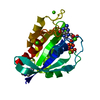
| ||||||||||||||||||
|---|---|---|---|---|---|---|---|---|---|---|---|---|---|---|---|---|---|---|---|
| 1 |
| ||||||||||||||||||
| Unit cell |
| ||||||||||||||||||
| Components on special symmetry positions |
|
- Components
Components
-Protein , 1 types, 1 molecules A
| #1: Protein |  HRAS / Transforming protein p21 / p21ras / H-Ras-1 / c-H-ras / Ha-Ras / GTPase HRas / N-terminally processed HRAS / Transforming protein p21 / p21ras / H-Ras-1 / c-H-ras / Ha-Ras / GTPase HRas / N-terminally processedMass: 18875.191 Da / Num. of mol.: 1 / Fragment: residues 1-166 Source method: isolated from a genetically manipulated source Source: (gene. exp.)   Homo sapiens (human) / Gene: HRAS, HRAS1 / Production host: Homo sapiens (human) / Gene: HRAS, HRAS1 / Production host:   Escherichia coli (E. coli) / References: UniProt: P01112 Escherichia coli (E. coli) / References: UniProt: P01112 |
|---|
-Non-polymers , 6 types, 150 molecules 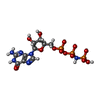










| #2: Chemical | ChemComp-GNP /  5'-Guanylyl imidodiphosphate 5'-Guanylyl imidodiphosphate | ||||||
|---|---|---|---|---|---|---|---|
| #3: Chemical | ChemComp-MG / | ||||||
| #4: Chemical | ChemComp-CA / #5: Chemical | ChemComp-YCN / |  Cyclen Cyclen#6: Chemical | ChemComp-ZN / | #7: Water | ChemComp-HOH / |  Water Water |
-Experimental details
-Experiment
| Experiment | Method:  X-RAY DIFFRACTION / Number of used crystals: 1 X-RAY DIFFRACTION / Number of used crystals: 1 |
|---|
- Sample preparation
Sample preparation
| Crystal | Density Matthews: 2.65 Å3/Da / Density % sol: 53.5 % |
|---|---|
Crystal grow | Temperature: 285 K / Method: vapor diffusion, hanging drop / pH: 7.5 Details: 17% PEG6000, 200mM CaCl2, 30mM TRIS/HCL, 5mM MgCl2, 2mM DTE, pH 7.5, VAPOR DIFFUSION, HANGING DROP, temperature 285K |
-Data collection
| Diffraction | Mean temperature: 100 K |
|---|---|
| Diffraction source | Source:  SYNCHROTRON / Site: SYNCHROTRON / Site:  SLS SLS  / Beamline: X10SA / Wavelength: 1.27982 Å / Beamline: X10SA / Wavelength: 1.27982 Å |
| Detector | Type: MARMOSAIC 225 mm CCD / Detector: CCD / Date: Sep 29, 2007 / Details: mirrors |
| Radiation | Monochromator: FOCUSED SI(111) MONOCHROMATOR / Protocol: SINGLE WAVELENGTH / Monochromatic (M) / Laue (L): M / Scattering type: x-ray |
| Radiation wavelength | Wavelength : 1.27982 Å / Relative weight: 1 : 1.27982 Å / Relative weight: 1 |
| Reflection | Resolution: 2.02→20 Å / Num. obs: 12483 / % possible obs: 97.8 % / Observed criterion σ(F): 0 / Observed criterion σ(I): 0 / Redundancy: 4.16 % / Biso Wilson estimate: 23.3 Å2 / Rmerge(I) obs: 0.046 / Rsym value: 0.047 / Net I/σ(I): 24.39 |
| Reflection shell | Resolution: 2.02→2.15 Å / Redundancy: 4.11 % / Rmerge(I) obs: 0.118 / Mean I/σ(I) obs: 10.85 / Num. unique all: 6809 / Rsym value: 0.135 / % possible all: 97.9 |
- Processing
Processing
| Software |
| ||||||||||||||||||||||||||||||||||||||||||||||||||||||||||||||||||||||||||||||||||||||||||||||||||||
|---|---|---|---|---|---|---|---|---|---|---|---|---|---|---|---|---|---|---|---|---|---|---|---|---|---|---|---|---|---|---|---|---|---|---|---|---|---|---|---|---|---|---|---|---|---|---|---|---|---|---|---|---|---|---|---|---|---|---|---|---|---|---|---|---|---|---|---|---|---|---|---|---|---|---|---|---|---|---|---|---|---|---|---|---|---|---|---|---|---|---|---|---|---|---|---|---|---|---|---|---|---|
| Refinement | Method to determine structure : :  MOLECULAR REPLACEMENT MOLECULAR REPLACEMENTStarting model: PDB ENTRY 5p21 Resolution: 2.02→19.92 Å / Cor.coef. Fo:Fc: 0.935 / Cor.coef. Fo:Fc free: 0.9 / SU B: 3.363 / SU ML: 0.098 / Isotropic thermal model: Anisotropic / Cross valid method: THROUGHOUT / σ(F): 0 / σ(I): 0 / ESU R: 0.19 / ESU R Free: 0.171 / Stereochemistry target values: MAXIMUM LIKELIHOOD
| ||||||||||||||||||||||||||||||||||||||||||||||||||||||||||||||||||||||||||||||||||||||||||||||||||||
| Solvent computation | Ion probe radii: 0.8 Å / Shrinkage radii: 0.8 Å / VDW probe radii: 1.2 Å / Solvent model: MASK | ||||||||||||||||||||||||||||||||||||||||||||||||||||||||||||||||||||||||||||||||||||||||||||||||||||
| Displacement parameters | Biso mean: 19.046 Å2
| ||||||||||||||||||||||||||||||||||||||||||||||||||||||||||||||||||||||||||||||||||||||||||||||||||||
| Refinement step | Cycle: LAST / Resolution: 2.02→19.92 Å
| ||||||||||||||||||||||||||||||||||||||||||||||||||||||||||||||||||||||||||||||||||||||||||||||||||||
| Refine LS restraints |
| ||||||||||||||||||||||||||||||||||||||||||||||||||||||||||||||||||||||||||||||||||||||||||||||||||||
| LS refinement shell | Resolution: 2.017→2.069 Å / Total num. of bins used: 20
|
 Movie
Movie Controller
Controller



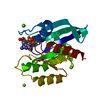
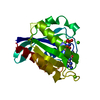


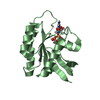

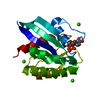


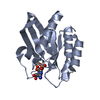
 PDBj
PDBj























